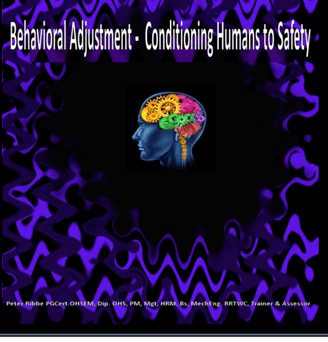 Behavioural Adjustment–Conditioning Humans to Safety
Behavioural Adjustment–Conditioning Humans to Safety
New Ebook by Peter Ribbe who says:
I would like to credit Dr. Robert Long (Human Dymensions)
With turning on the little lightbulb above my head with his books and writing’s. And the Australian Army, who gave me the methods and experience.
DOWNLOAD THE EBOOK HERE: Behavioural Adjustment – Conditioning to Safety
EXCERPT:
I am neither psychologist nor psychiatrist, although I have in the past had training as a lifeline phone councillor in suicide prevention, what I am is a safety person dedicated to preventing injuries and accidents in the workplace, and am solely focused on the work environment and not what people choose to do away from that environment . In order to understand the concepts of the psychology of risk takers, and inturn accident creators, I have read and studied a multitude of white papers, thesis, reports and models of risk and behaviours, trying to find something new that I could use in the workplace. I have studied and interviewed many workers, whom after an incident or accident, as part of the investigation process, I analysed to ascertain their thoughts preceding the accident. Their answers were widely separated and almost impossible to ascertain a common denominator into building a causation model, behaviours seemed erratic and extreme in some cases or circumstances, and I ended up asking myself, why do people do what they do? How can rational humans embark on a course of action that will harm them? What is the mental initiator that places them on the path of an unknown consequence? Many things have been promulgated and studied, and some action has evolved to try and understand, or rationalize and control these behaviours. Many models exist to try and control workers behaviours, behaviour based safety is one such model, there are many being used and all are different in concept or action.
I have read the “Risk Homeostasis Theory” this maintains that in any activity, people accept a certain level of subjectively estimated risk to their health and safety or other things they value, this is a valid argument, and is exhibited in the workplace, but it is not where we want people to exhibit such behaviours. I have looked at behavioural models like DiSC, “Dominance – Influence – Steadiness – Conscientiousness” by William Moulton Marston, this just gives a psychological profile, OK if you are in a HR department, not so useful in safety, you would need to evaluate every worker, and in a transient worker work place this is not possible.
So I have decided to move away from the risk control scenarios and modelling because it is the job of every safety person to identify and control risks in the workplace, therefore any modelling associated with risk is not what I am looking for. I need a deeper psychological approach to change or alter behaviour patterns in workers. I shall therefore look at some current models that cover this area. Dr. Robert Long (Human Dymensions) has designed a good starting point, where he has broken down the various models into (Safety Streams and Styles) in his white paper “The Zero Aspiration, The Maintenance of a Dangerous Idea” and is an appendix to the white paper, very good reading if you are planning a Zero Harm program in your workplace.
As stated by Dr. Robert Long (Human Dymensions), there are already a number of established and embraced styles of safety:
- Orthodox Legal
- Safety Science
- Behaviour Based Safety
- Zero Harm
- Process Based Safety
- People Based Safety
- Psychological Safety
- Social Psychological Safety
Each of these styles have associated streams, and each has merit in its own right, depending on your workplace and what it is you are trying to achieve there.


Do you have any thoughts? Please share them below